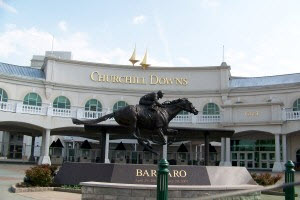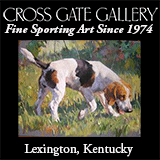racehorse
Scientists Claim Thoroughbreds Are Running Faster
For the past thirty years, conventional wisdom has held that horses have attained their maximum speed. Now, researchers at the University of Exeter in England claim that racehorses are running faster. Looking at data from more than 616,000 races run by more than 70,000 horses, these scientists have found the winning speeds greatly improved, particularly over the shorter distances. The big question, according to a professor at Exeter is whether the improvement is a result of breeding or technical changes. In the early 1900s, the speed of horses improved when jockeys shortened their stirrups and got out of the saddle. Speed improved again in the 1970s and 1980s when jockeys shortened their stirrups still further. How now to evaluate the effects of improved vet care, better draining of track surfaces, and hi-tech track surfaces that absorb energy from the horse’s footfalls and return a portion of that energy back to the horse in springiness? Click for more details in the complete article. Posted June 26, 2015
Read More
Is the Jockey Really an Athlete?
The still-fresh images of American Pharoah’s victorious jockey Victor Espinoza standing in his irons, fist in the air, cruising past the stands of cheering spectators, legs bobbling to absorb the shock of each footfall, provide a perfect segue into this article by Betsy Parker.
A jockey isn't really an athlete, After all, the horse does all the work, right? / David Chapman photo
Overheard railside at the Foxfield Races near Charlottesville: One pastel-clad college kid to the next as they rummage for beer in their cooler before noon on Saturday: “Jockeys aren't really athletes. They just sit in the saddle for a few minutes. I could do that!”
I almost fainted. Here the most provocative lede of the decade just dropped in my lap, and I couldn't get to the jock's room fast enough to dangle the mother of all conversation-starters like a tenderloin in front of a pack of hungry dogs. Hustling up the hill, I tried the assertion on jockeys Gerard Galligan and Brendan Brooks. They laughed.
“Anyone who'd say that has never ridden a race,” Galligan sniffed.
“Anyone who'd say that has never ridden a horse!” Brooks countered. “There's so much more to racing than 'riding.'”
As the Irishmen trailed off to walk the Barracks Road course, I jotted some interview questions. There was more to the story than laughing at a schoolboy's boast. It's not only athletic endeavor that drives competitiveness, as I'd soon find out. It's part will to win, part boldness. Part athletic concentration, part love of sport. It's a certain level of excitement tempered by highly-honed mental agility.
A 1980s University of North Carolina study measured that pound-for-pound, jockeys are the strongest, quickest, most agile and most hardcore athletes on the planet. Had the researchers studied jump jockeys, they'd've doubled it.
Is the Jockey Really an Athlete?
The still-fresh images of American Pharoah’s victorious jockey Victor Espinoza standing in his irons, fist in the air, cruising past the stands of cheering spectators, legs bobbling to absorb the shock of each footfall, provide a perfect segue into this article by Betsy Parker.
A jockey isn't really an athlete, After all, the horse does all the work, right? / David Chapman photo
Overheard railside at the Foxfield Races near Charlottesville: One pastel-clad college kid to the next as they rummage for beer in their cooler before noon on Saturday: “Jockeys aren't really athletes. They just sit in the saddle for a few minutes. I could do that!”
I almost fainted. Here the most provocative lede of the decade just dropped in my lap, and I couldn't get to the jock's room fast enough to dangle the mother of all conversation-starters like a tenderloin in front of a pack of hungry dogs. Hustling up the hill, I tried the assertion on jockeys Gerard Galligan and Brendan Brooks. They laughed.
“Anyone who'd say that has never ridden a race,” Galligan sniffed.
“Anyone who'd say that has never ridden a horse!” Brooks countered. “There's so much more to racing than 'riding.'”
As the Irishmen trailed off to walk the Barracks Road course, I jotted some interview questions. There was more to the story than laughing at a schoolboy's boast. It's not only athletic endeavor that drives competitiveness, as I'd soon find out. It's part will to win, part boldness. Part athletic concentration, part love of sport. It's a certain level of excitement tempered by highly-honed mental agility.
A 1980s University of North Carolina study measured that pound-for-pound, jockeys are the strongest, quickest, most agile and most hardcore athletes on the planet. Had the researchers studied jump jockeys, they'd've doubled it.
Horse Collides with, Injures Racing Official at Gold Cup
Foxhunter and amateur whipper-in Peter Hitchen was injured while officiating at the Virginia Gold Cup Races at Great Meadow Park, Warrenton, Virginia, Saturday, May 2, 2015. Hitchen, who was on foot, was hit by a racehorse and suffered multiple breaks. Hitchen was taken to a hospital in Fairfax where the damage was assessed: fourteen broken ribs, collar bone broken in two places, and three broken vertebrae. Surgery was considered, but after a second opinion the decision was made to move him to the Reston Spine Center. Currently in a cast, Hitchen faces a long recovery. This report will be updated as new information becomes available. Posted May 7, 2015
Read More
Winning in Tax Court with Thoroughbreds
Peter J. Reilly, writing in Forbes, tells of a recent tax court case won by a taxpayer claiming horse business losses, despite the taxpayer’s failure to satisfy all the classic IRS tests. The taxpayer was a successful businessman whose annual salary averaged around one million dollars from his concrete business. He suffered losses, however, from his other business—owning and racing Thoroughbreds—from which he obviously derived much pleasure. He passed some of the IRS tests, but was weak in others. However, he worked very closely with his trainer, and it was that relationship upon which the case turned. The IRS questioned, with good reason, the intensity of the taxpayer’s profit motive. However, because the taxpayer worked so closely with his trainer, the court decided that the two were essentially embarked on a joint venture, and that the trainer certainly had a strong profit motive, in that training and racing Thoroughbreds was his primary business. The court concluded that the taxpayers motive was, therefore, the same. Click to read the complete article. Posted November 22, 2014
Read More
The Road to the Kentucky Derby
 Odds are high that most Foxhunting Life readers will tune in to the Kentucky Derby on the first Saturday in May to watch "the most exciting two minutes in sports." It's arguably the finest show of racing talent each year from the horses to the trainers to the jockeys who are all aiming for the glory of winning the Kentucky Derby cup and sharing in the two million dollar purse.
Odds are high that most Foxhunting Life readers will tune in to the Kentucky Derby on the first Saturday in May to watch "the most exciting two minutes in sports." It's arguably the finest show of racing talent each year from the horses to the trainers to the jockeys who are all aiming for the glory of winning the Kentucky Derby cup and sharing in the two million dollar purse.
Websites like www.kentuckyderbybetting.com are excellent resources to get you up to date on the background and history of the 'Run for the Roses.' There is also a section on Kentucky Derby horse odds which is invaluable if you are planning on increasing the excitement by having a flutter on your favorite contender this year.
It's easy to get emotionally attached to a horse that you believe can win the big prize. Some foxhunters take the connection even further by buying retired racehorses and giving them a whole new lease on life. Here's a recent FHL article on Thoroughbreds in the hunting field.
At Galway Races
William Butler YeatsWith hunt point-to-points kicking off the racing season, we thought it appropriate to elevate our discourse with a little Yeats. There where the course is,Delight makes all of the one mind,The riders upon the galloping horses,The crowd that closes in behind:We, too, had good attendance once,Hearers and hearteners of the work;Aye, horsemen for companions,Before the merchant and the clerkBreathed on the world with timid breath.Sing on: somewhere and at some new moon,We’ll learn that sleeping is not death,Hearing the whole earth change its tune,Its flesh being wild, and it againCrying aloud as the racecourse is,And we find hearteners among menThat ride upon horses. A literary giant of the twentieth century, William Butler Yeats (1865–1939) was the first Irishman to receive the Nobel Prize in Literature. Posted March 20, 2013 ... This content is for subscribers only.Join NowAlready a member? Log in here
Read More
And the Chase Is On
 And the Chase Is On, bronze sculpture by Margery Torrey, will benefit injured jump jockey Jake ChalfinHere is a delightful work of art by sculptor Margery Torrey that will bring a smile to any foxhunter. Torrey is one of a number of generous individuals who have donated their unique talents to help raise funds for injured jockey Jake Chalfin.
And the Chase Is On, bronze sculpture by Margery Torrey, will benefit injured jump jockey Jake ChalfinHere is a delightful work of art by sculptor Margery Torrey that will bring a smile to any foxhunter. Torrey is one of a number of generous individuals who have donated their unique talents to help raise funds for injured jockey Jake Chalfin.
A little over a year ago, during a hurdle race at the Blue Ridge Fall Races, a runaway racehorse he was riding catapulted Chalfin into the perimeter fence. It turned out to be a life-changing event for Chalfin. He remains paralyzed from the chest down.
Thoroughbred Market in Doldrums
The market for even well-bred Thoroughbreds has suffered substantially since the global market crash of 2008. “The old million-dollar horse is now a $500,000 horse,” said Geoffrey Russell, Director of Sales at Keeneland. In the first session of the September Yearling Sales this year, the two highest selling colts went off at $1.4 and $1.2 million. On the second night, a filly went for one million dollars and another for $750,000. After two days of sales, the gross and the median prices for 2011 compared to 2010 were substantially the same, but the third session ended better, showing a twenty percent increase over last year. For more details, click here. Posted September 14, 2011
Read More
Thoroughbred Industry Woes Linked to Medication
The Thoroughbred racing industry is tanking in the U.S., and racing industry leaders from around the world blame the decline on our permissive medication practices. From 2007 to 2010, on an annual basis, the registered foal crop in the U.S. declined nineteen percent, races run declined almost ten percent, purses fell more than twelve percent, and betting dropped twenty-two percent. World racing leaders spoke up at a recent International Summit on Race Day Medication at Belmont Park on June 13 and 14. Denis Egan, the chief executive of the Irish Turf Club, said, “European buyers are drifting away because we view the performance of U.S. horses with skepticism because of the medication policies, and the stallions are not comparable to clean European stallions.” The Hong Kong Jockey Club has perhaps the most stringent medication rules in the racing world. Yet Hong Kong, with a population of seven million, and with racing only eighty-three days per year, saw nearly $10.3 billion in bets pass through the windows last year—almost as much as the entire U.S. The strict policies are good for business, insists Bill Nader, executive director of the Hong Kong Jockey Club. Over the past five years only one racehorse in 5,692 experienced sudden death while racing. In the U.S. the fatality rate is one in five hundred starters—worse by a factor of more than ten. Much of the conference’s focus was on Lasix, a drug used to reduce exercise-induced bleeding in the lungs. Lasix also improves performance, so nearly all horses in the U.S. go to the gate with a dose of the drug, whether they need it or not. Dr. Anthony Stirk, senior veterinary advisor to the British Horse Racing Authority urged American horsemen to get in step with the rest of the world, not only in medication policies but also in racing less frequently. Joe Drape’s article of June 13 in the New York Times is the source for this material. Posted June 15, 2011
Read More



















